Text
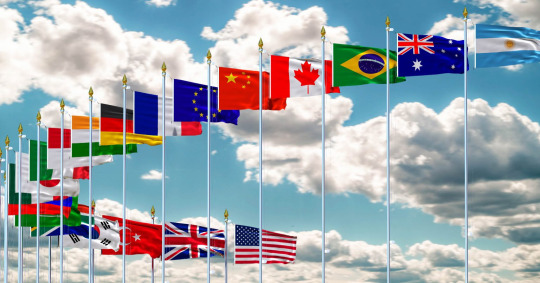
Changing World Order: (Im) balance of Power in Eurasia.
The disintegration of the USSR and the end of the Cold War proved to be a global paradigm shift in the sense that various developments following these two pivotal events changed the course of global affairs. It paved the way for a US led ‘unipolar’ world order. Commentators like Fukuyama declared ‘the end of history’ and the triumph of the ‘liberal global order’. Another important shift was from traditional ‘inter-state’ conflicts to ‘intra-state’ conflicts. Except for military campaigns by Russia, the US, and Israel primarily in the Middle East, Caucasus, and Balkan, we have not seen any full-scale inter-state conflicts. Rather they were replaced by ‘intra-state’ civil wars and unrest existing in various corners of the globe.
However, after the 9/11 attacks, the US hegemony has been challenged by various states and other non-state actors. Trump’s presidency was a decisive period in global politics it became evident that the US was struggling to maintain its stature and position in world politics. The Middle East and Eastern Europe were traditionally Western Spheres of influence. Obama’s ‘Asia Pivot’ in the ‘Indo-Pacific’ created a power vacuum in the Middle East and Eastern Europe leaving space for Russian and Chinese aggression. This became one of the contributing factors in the annexation of Crimea in 2014 and the ongoing war between Russia and Ukraine. The US lost its influence in the Middle East which was discernible in the case of Syria and Afghanistan. The successive isolationist policies of the Trump administration emboldened China to exercise its power in multilateral organizations.
Furthermore, the regional politics of the Middle East changed significantly in terms of power dynamics. Until 2020, only two Arab countries-Egypt (1978-79) and Jordan (1994) normalized their relations with Israel. In 2020, Israel managed to normalize its relations with four more Arab countries- the UAE, Morocco, Sudan, and Bahrain. The US recognized Jerusalem as the capital of Israel in 2017 by relocating its embassy there. Isolation of Iran in regional politics is an outcome of these developments.
The US has been trying to champion the Indo-Pacific region; partly because Hillary Clinton propagated ‘Asia-Pacific’ as the driver of global politics, partly because of the China Trap as G. T. Allison would put it. The geo-political competition in the Indo-Pacific region commenced with the introduction of the strategic rebalancing policy of the US towards Asia – namely the ‘Pivot to Asia Policy’ by the US and the inauguration of the strategically ambitious ‘geo – economic’ infrastructural project of Belt and Road Initiative by China. China’s ‘reclamation’ of contested territories in the South China Sea and intrusion in the Indian Ocean along with other developments compelled the US and its allies to rejuvenate QUAD (The Quadrilateral Security Dialogue).The Indo-Pacific Theater brought together reluctant partners of the US closer. The US started taking part actively in the partnership, preparedness, and promotion of a networked Indo-Pacific region. The middle powers such as India, Japan, and Australia have been working in the direction of creating a middle power coalition. Recently, the ambitious Indo-Pacific Economic Framework (IPEF) was launched on May 23, 2022, by President Joe Biden with fourteen participating members. However, except for Japan, most of the countries did not show as much willingness as the US envisioned.
China, on the other hand, is working hard to win credibility from the Indo-Pacific countries through lucrative financial investments under the BRI and Maritime Silk Road Initiative (MSRI) frameworks. Due to China’s heavy investments, the countries of South Asia, Southeast Asia, and to some extent, the Middle East have become battlegrounds for asserting hegemony for China and the US. Many of these destination countries, despite pressure, do not want to take any side or limit themselves to a block but want to harness the opportunities by avoiding any possible conflict of interest. Japan, despite having a huge trade dependency on China, continues embracing the US. Australia is repelled by China on a range of issues from Taiwan to the Southwest Pacific. Russia is getting closer to China, especially since the Ukraine invasion. As pointed out by the Chinese foreign minister, they both have “strong resilience and strategic determination.” As of now, China has not termed the ongoing Russian-Ukraine conflict as an ‘invasion’ and even initiated a diplomatic outreach campaign to advance its interests in the Indo-Pacific by supporting Russia’s cause if not directly.
India has adopted an unconventional approach by taking considerable bold posturing in its foreign policy stance; focusing on its ties with the US when it comes to the Indo-Pacific region. This has undoubtedly caused a deterioration of India’s bilateral relations with China. Since the Galwan clash, both countries have not made any significant progress in resolving border disputes. After the G219 highway, China is now constructing another highway called G695 national expressway through Akshai Chin connecting Tibet with Xinjiang. The new highway route passes even closer to the Line of Actual Control (LAC) compared to the past one. Despite these developments, relative progress has taken place through the BRICS National Security Advisors (NSA) talks where both the countries seem to cooperate on issues such as counter-terrorism. Overall, Eurasia is again the center of geopolitical competition. With the decline of the US hegemony and a rising China, regional stability is being challenged, leaving less scope for co-operation and increasing conflict.
0 notes
Text
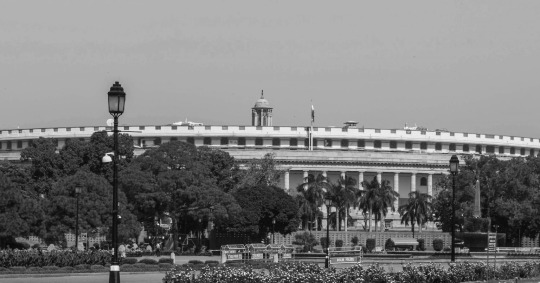
The Exigency for an Active Parliament for Building a Vibrant Democracy.
On May 13, 2022, the Indian Parliament completed 70 years since its first session. The first session of Lok Sabha and Rajya Sabha commenced on May 13, 1952. The Lok Sabha is currently in its 17th (2019- 2024) session. The Parliament is the supreme law-making institution in India, where a draft bill is presented as a legislative proposal, when passed by both houses of parliament and assented to by the country’s president, becomes an Act of Parliament and the law of the land.
The statistics recently released by the PRS Legislative Research throw insight into how parliamentary standards have declined over the years, which calls for a severe relook into how our Parliament has been functioning. The Parliament has been in session for fewer days than earlier, from an average of 121 days from 1952-70 to 68 days since 2000, and this trend continues even now. Even in a few parliamentary sessions, participation in the parliamentary debates is low. In July 2019, a debate on malnutrition among women and children lasted 1 hour with only 10 participants. Just before the first wave of Covid-19, the debate around the threat of the outbreak lasted for 40 minutes with only 19 participants, which is indicative of the decline in participation of parliamentarians. The lack of participation by the members in the debates and fewer sessions of Parliament is a grave concern. Moreover, the 17th Lok Sabha’s monsoon session passed nearly 20 bills without any debate, of which 11 bills were passed in 8 minutes without any debate and discussion. The hasty passage of bills without discussion violates Article 107, which says that no Bill shall be deemed to have been passed unless both houses agree. The makers of the constitution could have used the term ‘passed.’ Still, they used the term ‘agreed’ with the intention of not passing the bills, namely by voting but wanted both Houses of Parliament to discuss legislative proposals thoroughly before agreeing to them.
Another unfortunate development that is being observed is regarding the setting up of parliamentary committees, which are supposed to be in operation even when parliament is not in session. Why are parliamentary committees important? Due to the complexity and wide range of issues that Parliament debates upon, it is necessary to have the technical expertise to comprehend the issues being raised. So the bills are sent to committees to ensure proper scrutiny before passing them, which has immensely contributed to the strengthening of the laws. Since 2004, only 45% of bills have been referred to Parliamentary Committees. Only 20% and 10% of the bills in the 16th and 17th Lok Sabha have been sent to Parliamentary Standing Committees. There have been 134 bills introduced in three years by the Lok Sabha., 114 of which have been passed. Only 13% of bills have been sent to parliamentary committees. In the United Kingdom, all bills are sent to committees for examination and scrutiny. The Central and State Legislative Assemblies have diminished in stature with the introduction of the ‘Anti-Defection Law’ in 1985, which was intended to prevent lawmakers from leaving one party for another, it also introduced the party whip system. It has transformed the legislative institutions into halls of whip-driven tyranny, where it prevents lawmakers from exercising their freedom of speech and conscience.
In a nutshell, it is incumbent on the parliament to function for a longer duration of time to accommodate a wide range of debates on matters of public importance and national challenges. The active presence and debate of parliamentarians are essential for constructive debates and discussions in the parliament which is an essential obligation of Parliamentarians towards citizens. There is a necessity for relaxation of some provisions in the ‘Anti-Defection Law’ agreeing that an MP or an MLA can be disqualified for violating the party whip on confidence motions, no-confidence motions, adjournment motions, money bills, or financial problems. The legislative domain needs to be free quorum so that a lawmaker should not be compelled to follow the party whip and be able to vote against a legislative proposal if they disagree with their party’s official stance. In a participatory democracy, a citizen’s responsibility shouldn’t end simply with the act of voting, which is right now the case. There needs to be greater public participation in the lawmaking process from citizens themselves. It is not the government’s sole responsibility to create an enabling environment for debates, discussions, consultations, and parliamentary scrutinies. It is the responsibility of citizens too to take an interest in matters of public importance, but the general perception among citizens is that of an MP or an MLA as a middle man to the executive in getting access to the public goods for one’s constituency. Citizens are interested in using the influence of MPs and MLAs for recommendations for personal benefits. So, to improve the law-making process, citizens need to hold legislatures and the government accountable by increasing people’s participation and making legislatures not only functional but also prosper to lead our ways to good governance.
0 notes
Text

Beware of Rainbow Washing!
Pride Month just got over, and brands couldn’t get enough of it with the beautiful rainbow colours and scores of artistic creativity; starting from Burger King’s Pride Whopper with ‘top’ and ‘bottom’ buns and lusciously chopped vegetables to a variety of limited edition tie-dye rainbow prints and other rainbow-coloured garments. I, too, wanted to flaunt such merchandise as a proud ally and own it. However, it struck me, am I being rainbow washed?

But first, why is Pride Month celebrated throughout June? Pride Month is celebrated to commemorate the Stonewall Riots in USA, which began in the last week of June 1969 and paved the way for the Lesbian, Gay, and Transgender Communities’ fight for equal rights. The police raided the Stonewall Inn in New York’s Greenwich Village, a common gathering place for the young and old members of the LGBT community. These protests went on for five long days. On November 2nd, 1969, the idea of a march in response to the riots was proposed at the Eastern Regional Conference of Homophile Organizations in Philadelphia. On June 28th, 1970, a year after the Stonewall Riots, they marched through Christopher Street which became the epicentre of the riots and June 28th came to be known as the Liberation Day. The theme was ‘gay pride,’ and the slogan “Say it clear, say it loud. Gay is good, gay is proud” could be heard everywhere. Later, the month of June was officially recognized by Bill Clinton in 1999, followed by Barack Obama declaring June as the ‘LGBT Pride Month.’ it is the current President Joe Biden, who went a notch ahead and declared it as the ‘LGBTQ+ Pride Month’ to include everyone from the vast community. Many countries have followed suit and today June is celebrated as Pride Month globally with Kolkata’s 1999 Pride March being India’s first.
With a painful yet rich history to this celebration, brands have been seen to misuse it to their benefit. Rainbow washing, as the act is named, is where brands use Pride Month and take incidental advantage of the various colours it represents, by benefitting from the false inclusive marketing of its products. These companies are merely marketing this month for their own profits while in reality they may not believe in diversity or inclusion or worse still, indulge and support anti-LGBT practices. This is similar to Greenwashing (companies lying/falsely marketing their products to be sustainable and environmentally friendly by changing logos/banners etc. to shades of green, brown or yellow) or Pinkwashing (brands that misleadingly use the pink ribbon logo that symbolizes support for breast cancer charities). Not only is it wrong in the sense that it conveys a false message and outrightly lies to its customers, but also that it dilutes the underlying message and intention of Pride month.
Let’s examine the two examples given above. Burger King had to issue an apology for its widely criticized advertisement of the ‘Pride Whopper’ as it spoke about having two ‘tops’ and two ‘bottoms’ and hence completely misrepresented sex in the LGBT community. People called it an entirely tone-deaf campaign while marketing the ‘matching top buns.’ Bewakoof.com came out with a wide range of quirky rainbow-coloured products during the month. However, a deep dive into their history showed a grossly homophobic meme in 2015, which was taken down after an uproar by blogger Divya Roop. “Save the girl children or else 25 years later your son will come home and say Asha to mili nahi so Ashish le aya”. For a campaign meant to spread the message of ‘Save the Girl Child’, a homophobic route was taken. While the company had apologized for this marketing tactic, it gives an insight into the double standards. These brands latch on to this exclusive opportunity yearly and then forget about it for the rest of the 11 months. What we must ask is, do we really want to spend extra money on such ‘limited edition products?
Mansi Shanbag, a Lead Copywriter at WATConsult, very clearly says, “BRANDS ALWAYS WANT TO BREAK CLUTTER. BUT WHEN IT COMES TO PRIDE MONTH, THEY ARE ALL ABOUT SPAMMING. It is so very easy to stick a rainbow on your product, your logo, your name for a month and do absolutely nothing to actually contribute to the movement”. Companies should consult queering personalities and listen to their opinions before they can prove their allyship to the LGBT community.
Acko released an advertisement starring Neeraj Kabi in 2021 to promote its pride campaign. The ad showed him changing his social media profile picture to the colours of the pride and then proudly showing that off to his friends. His friends pat him on his back, assuming he had accepted his son’s sexual identity. This leaves him speechless as he tries to accept and digest this reality. “Post pride, Support pride, but more importantly, be ready to accept Pride” was Acko’s slogan. To ally with the community is not to merely flaunt its colours but also to readily accept and empathize with the soul of the idea. Are we ready to do that in the non-pride months?
0 notes
Text
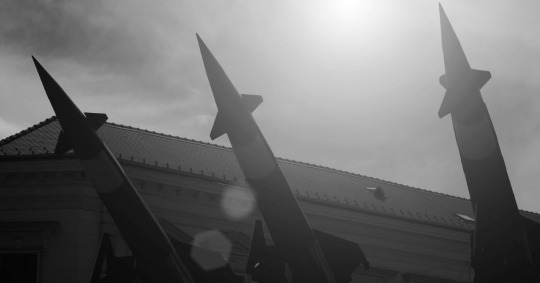
Nuclear non-proliferation, still an age old problem.
The Treaty on Nuclear Non-Proliferation (NPT) was signed in 1968 and entered into force on 5 March 1970. On 11 May 1995, the Treaty was extended indefinitely. With 191 states as signatories to the treaty it is the most significant treaty to stop the non-proliferation of nuclear weapons. However, some nuclear states like India, Pakistan, Israel and the newly formed state of South Sudan are not signatories to the NPT.
With only five nuclear weapon states having signed the treaty, it is at the centre of a lot of international politics. China, France, Russia, U.K and the U.S.A are the only countries recognized by the treaty as Nuclear weapon states. They also happen to be the P5 or the Permanent Five at the United Nations Security Council (UNSC).
At the heart of this dispute is how the treaty defines a nuclear weapons state and differentiates it from a non-nuclear weapons state thus dividing the world into nuclear haves and have-nots. A Nuclear-weapon state is defined as those that manufactured and exploded a nuclear weapon or other nuclear explosive device before 1 January 1967. Articles 2 and 4 of the treaty requires countries to give up any present or future plans to build nuclear weapons in return for access to peaceful uses of nuclear energy.
These clauses were enough to keep countries like India away from signing the treaty in 1968. India opposed it, calling it a discriminative disarmament policy and called for the complete ban of nuclear weapons. However, a complete ban was unacceptable to the already nuclear armed nations who were in the midst of an arms race post the Second World War nuclear disasters in the cities of Hiroshima and Nagasaki in Japan.
One of the original signatories to the NPT in 1970 was Iran. But soon the International Atomic Energy Agency (IAEA) which is tasked with the implementation of the treaty reported that Iran was not complying with the Agreement and had started its weaponization program in 2003 including a secret project to enrich uranium. Soon the Joint Comprehensive Plan of Action (JCPOA) was signed between Iran ad six world powers where Iran agreed to inspection in return for sanctions relief. With U.S.A withdrawing from the JCPOA in 2018 Iran warned that it will leave the NPT and started to enrich its uranium.
Another case is of the Democratic People’s Republic of Korea (DPRK) or North Korea which had ratified the NPT in 1985 but announced in 2003 that it would no longer be bound by the treaty. We see everyday reports of Kim Jung Un overseeing the testing of nuclear missiles which are aimed at Seoul. North Korea’s withdrawal constitutes a significant challenge to the NPT as it has been the first and only country to withdraw from the NPT. No amount of sanctions by the international comunity is able to deter it from the path to becoming a nuclear-weapon state.
The NPT rests on the three pillars of – disarmament, non-proliferation and the peaceful uses of nuclear energy. But disarmament has been one of its biggest failures. There is also no progress in including the remaining nuclear weapons possessors, India, Pakistan and Isreal into the treaty. The peaceful use of nuclear energy is also easier said than done. The world has seen plenty of nuclear accidents post the signing of the treaty like Fukushima (2011), Chernobyl (1986), Three Mile Island (1979). It is argued that to reduce global warming, the world needs more non-carbon emitting nuclear energy, and the IAEA and the Nuclear Energy Agency (NEA) of the OECD project a major increase in nuclear energy use as a result of concerns over global warming.
The peaceful use of nuclear energy can also pose risks like cancer, meltdown risk, weapons proliferation risk, toxic nuclear waste, nuclear accidents, etc. Hence we can safely say that the original demand made by India that nuclear weapons should be completely banned, is one of the most foolproof ways in which we can prevent disasters and save humanity. Treaties like the NPT which have been designed for the comfort of few nuclear armed nations to lord over the developing and less developed nations need to be completely revamped and this kind of discrimination should be brought to a halt.
The NPT at Fifty: Successes and Failures
North Korea and the NPT
Iran and the NPT
0 notes
Text

Promoting Gender Diversity and Integrating the Gender Perspective in Indian Intelligence Agencies.
Promotion of Gender Diversity and Integration of Gender perspective has recently received much attention across domains, but IndianIntelligence Agencies seem to be an exception. Indian Intelligence agencies have failed to become a major part of this discourse. There have been reports and talks around the reforms in intelligence agencies like the IDSA Task Force report “A Case for Intelligence Reforms in India” by R. Banerji and the Bill for Intelligence Reforms introduced by Mannish Tiwari in 2011, but they have all failed to incorporate the gender dimension. Also, though India supports UN Women, Peace and Security (WPS) Agenda, there seems to be a dissonance between India’s international display by contributing female peacekeepers to UN peacekeeping missions and the situation back home (Seth, 2022).
Promoting gender diversity in intelligence institutions is of significance for various reasons. Individuals recruited from diverse backgrounds with different skills, expertise, problem-solving approaches, ideas, perspectives, and cultural experiences will help improve the productivity and quality of engagement and lead to innovation and creativity in intel agencies. Seeing the issue from a gender perspective will strengthen intelligence products and help better decision-making (“Foreign Territory: Women in international relations,” 2019). The options for recruiters will improve as more applicants can apply, attracting the best talent. The intel workforce should reflect the diversity in society, gender diversity is crucial. Inclusion will enhance public trust and confidence in these institutions. Such an approach will also empower the disadvantaged genders.
If we specifically focus on women, some studies and opinions highlight that some skills women possess are most needed for intel jobs. One of the former female agents at the CIA argued that women are better at people skills, i.e., they can read people better, which includes determining their motivations and vulnerabilities; they’re street smart, i.e., they can easily read the potential danger and escape threats proactively; they are better at training foreign assets and are better listeners on the job (Zeigler, 2012). Thoughassociating certain skills with a specific gender can be seen as a perpetuation of stereotypes, it can be viewed as a result of the gendered structures that have been around for centuries, which we strive to change. Tamir Pardo, the head of Mossad, in one of his interviews, said that female agents have a distinct advantage in secret warfare because of their better ability to multitask and suppress their ego to attain goals vis-à-vis men and contrary to the stereotypes, women are good at deciphering situations and their abilities are superior to men in terms of understanding the territory, reading situations, spatial awareness (Zeigler, 2012). The ‘UN Security Gender and security Toolkit’ elaborates that WPS Agenda is important for intelligence agencies as it promotes gender inclusion and advocates using gender analysis for conflict impact, resolution, and recovery, and talks about how women can play a significant role in reducing the harm of gender-based violence and discrimination. UNSCR 2242 calls for the integration of gender in the counterterrorism approach and emphasizes developing gender focussed evidence-based policies to deal better with the impacts of violence on women by conducting gender-sensitive research (DCAF, OSCE/ODIHR, UN Women, 2019).
Seeing the growing number and changing nature of security challenges, adopting a gender-inclusive approach in India’s security and intelligence policy has become far more relevant. India must soon develop a policy with a broad vision for gender inclusion in security and intelligence. A gender-diverse expert committee to review after such a policy is drafted is a must. I doubt if our traditional institutional structures are fully capable of gender-inclusive policymaking. Implementing the provisions of such a policy will need a strategy, resource management, political will, and moving away from systemic inertia. A multi-pronged strategy focussing on recruitment-promotion of diverse genders at all levels, across all intel functions – intelligence collection, collation, control, analysis, and research, and from diverse educational and cultural backgrounds with a gender-inclusive workplace can be deployed. Such a reform, along with other suggested reforms in intel agencies, is in our larger strategic and geopolitical interest. It will impact India’s foreign policymaking and better integrate humanitarian aspects in security and crisis response situations.
Other countries of the world have made significant progress in this regard. USA’s Intelligence Community Diversity and Equal Opportunity Report 2020, UK’s Diversity and Inclusion in the UK Intelligence Community Report 2018, Australia’s ONA Diversity Action Plan 2015-2018, and New Zealand’s Diversity and Inclusion Strategy 2017–2020 reflect this progress. Mossad has 40% females in its staff, with 24% in key senior roles, and is seeking to add more women. Learning from them, India must take concrete steps with necessary modifications in this direction. The best practices employed in other sectors like corporates for gender diversity can also be explored. Indian Intelligence, Security and Foreign policy, thus, need to undergo a structural gender overhaul.
Bibliography
DCAF, OSCE/ODIHR, UN Women (2019), “Intelligence and Gender”, in Gender and Security
Toolkit, Geneva: DCAF, OSCE/ODIHR, UN Women: Gender and security toolkit
Foreign territory: Women in international relations. (2019, July 9).
Lowy Institute: FOREIGN TERRITORY: WOMEN IN INTERNATIONAL RELATIONS
IDSA Task Force. (2012). A case for intelligence reforms in India.
Manohar Parrikar Institute for Defence Studies and Analyses: A Case for Intelligence Reforms in India
ORF: Bill on Intelligence Agencies Reforms
Seth, S. (2022, June 10). India’s inconsistent adherence to the women, peace and security agenda.
Lowy Institute: India’s inconsistent adherence to the Women,Peace and Security agenda
Zeigler, M. (2012). Why The Best Spies in Mossad and The CIA Are Women.
Forbes: Why The Best Spies in Mossad And The CIA Are Women
0 notes
Text

The Importance of Early Sexual Education in Indian Schools.
In a country that houses a population of 1.38 billion people, talking about sex is still taboo. Sex education programs in India receive backlash from parents, conservative religious organizations, and cabinet ministers. Pre-marital sex is viewed as immoral and sinful by many. It is considered against our culture; hence there is no need to educate children about sexual health.
According to the United Nations Population Fund, Sexual Education, “aims to advance and strengthen the ability of children and young people to make conscious, satisfying, healthy and respectful choices concerning relationships, sexuality and emotional and physical health”. Studies have shown that sexual education at an early age improves the health of children. The World Economic Forum and other experts assert that Comprehensive Sex Education can prevent rapes. A study conducted at Columbia University shows that sex education in school protects students from sexual assault in college (Santelli et al., 2018).
In India, chapters on reproductive biology are not taught in many schools. Since sex is a private topic, some—primarily teachers—believe it should be taught at home, not in school. Regardless of place, many girls are not told about menstruation before it begins since it must be hidden. Young boys are not taught about menstruation because “it does not concern them” and is still a taboo topic. Children are deprived of understanding the critical changes in their own bodies. Such stigmatization of sexual education results in adolescents facing sexual and reproductive health issues that are, in fact, preventable.
Contree Foundation conducted a survey of 1,008 men and women from 21 villages aged between 14 to 19 to study whether adolescents know about sexual and reproductive health. The sample included both married, and unmarried males and females.
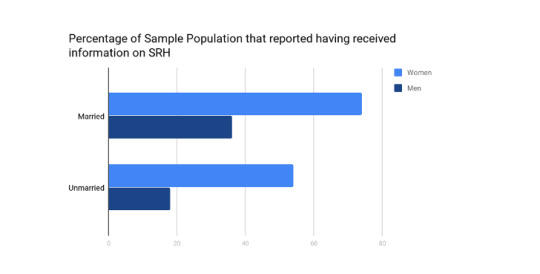
Unsurprisingly, the survey results established that Indian adolescents do not have access to comprehensive sexual education. The study found that a higher number of adolescent boys lacked information on Sexual and Reproductive Health as compared to girls. This could be because some mothers briefly explain what marriage entails to girls before their wedding. As shown in the graph, 74% of married women said that they received some information about methods of contraceptives and pregnancy. 54% of unmarried women and only 36% of married men reported having received some information on the same. The numbers are even worse for unmarried adolescents: 18% of unmarried men reported having such knowledge. Overall, there has not been much improvement in teenage pregnancy, as mentioned in the 2017 National Family Health Survey-4 to the latest National Family Health Survey-5. Under Ayushman Bharat, the Government of India launched the School Health Program in 2018. In early 2020, NCERT released the ‘Health and Wellness Curriculum’ for the program. This program that teaches sexual education to students does not even mention the word ‘sex’; instead, it uses the phrase ‘adolescence education.’
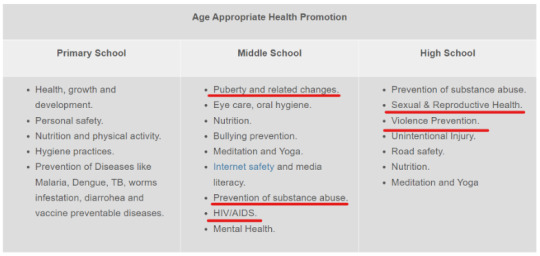
Among the 11 modules, two focus on reproductive health and HIV prevention; safety and security against violence and injuries. Highlighted sections in the school health program are concerned with sexual and reproductive health. This program will choose one male and female teacher from each public school as ‘Health and Wellness Ambassadors’ who will be trained to teach and conduct sessions and activities. While it is considered better than its predecessor, this program lacks some crucial components to make its vision successful.
Recommendations:
Incorporate Comprehensive Sexual Education guidelines put forth by the UNPFA. The four-year-old children should be taught what consent is. Basic knowledge of menstruation should be given to girls before they hit puberty: in primary school instead of middle school. They should also be taught to differentiate between ‘good touch’ and ‘bad touch,’ to help children reach out to parents if they face unwanted touches from others. Since many children face sexual abuse/harassment in India, educating children early will help protect them.
While the modules include some education on gender identities such as mentioning “[G]ender is socially constructed and thus can be changed over time. We are all equal and deserve to be treated equally,” it does not go deep enough to educate them about the gender spectrum and sexual orientations. There is a need for robust inclusion of education on gender identity and sexual orientation to sensitize students about women’s rights and Queer rights.
The curriculum’s focus should range from preventing STIs and pregnancies to where and how people can seek help if they are either infected with an STI or have gotten pregnant accidentally.
The stigmatization of sex and its education is so entrenched in Indian society that the curriculum must focus on the normalizing conversation around these subjects.
At least one session must be conducted for each age group that educates parents about the sexual and reproductive health of the children and how they can support them.
The central and state education ministries were not consulted while drafting this curriculum. They are important stakeholders and should be given the opportunities to contribute. Moreover, this program should be integrated into the new National Education Policy.
The government should train ‘Health and Wellness Ambassadors’ so they can serve as professional sex educators. Some civil society organizations have worked in this domain for years.
0 notes
Text

Time to be “Significant”
“What you do makes a difference, and you have to decide what kind of difference you want to make.”– Dr. Jane Goodall, Scientist & Activist
Christened the “World Environment Day,” June 5th, this year marks half a century since the inception and foundation of the moral principles to encourage and direct countries and people to preserve and enhance the human environment in Stockholm, also known as the 1972 Stockholm Conference. This indeed was the cornerstone for it heralded the admission of “Environment” as a sprouting and salient issue of global importance. It led to the marriage of science and society that gave birth to environmental laws and established institutions bearing environmental impacts. It set the ball rolling for international environmental diplomacy and, through these years, also prophecised the goliath we are now confronted with – climate change. We have come a long way since then, where stakeholders now convene to tackle the Earth’s triple planetary crisis – climate, nature, and pollution and facilitate the fulfilment of SDGs, the 2030 Agenda, the Paris Agreement on Climate Change, the post-2020 Global Biodiversity Framework, and support the adoption of green post-COVID-19 recovery plans at Stockholm+50. What will be interesting to witness is the outcome of the Stockholm+50 meeting for which my fingers are crossed.
At this juncture, it is too bold of me to comment on what other counties are doing or have committed to tackling the planetary crisis and hence will restrict myself to India. The honorable Prime Minister Narendra Modi advanced India’s formula of ‘Panchamrits‘ at the COP 26, where India will,
increase its non-fossil energy capacity to 500 gigawatts by 2030
meet 50% of its energy requirements through renewable energy by 2030
reduce its forecasted carbon emission by one billion tonnes by 2030
reduce the carbon intensity of its economy by 45% by 2030
achieve net-zero by 2070
This is a testament to India’s bold vision and dedication to the collective global battle against the aforementioned crisis. It is, in fact, one of the very few nations on course to meet its Paris Agreement targets , and hence, it is fair to state that it is on its path to being successful.
Nevertheless, having said that, I believe it is important for India not to focus on being successful. Yes, you read that correct; I do not want India to be focused on being successful. Don’t get me wrong; every country ought to be successful, and I hope India does too. There is no harm or nothing wrong with being successful. But, success is just about oneself. I instead want India to be “Significant.” because significance is about others. And I want India to be significant both domestically and Internationally.
Domestically, it is paramount that India does not abandon the development needs of the most vulnerable communities. And hence, this planetary crisis must prioritize equity, exchange, and access; and have a human rights-based approach where development, along with mitigation and adaptation measures, fortifies the resilience of such vulnerable constituents.
Internationally, it is paramount that India puts its best foot forward, contributes to the international stage, and extends a helping hand to the most vulnerable nations and communities. To quote Dr. Shashi Tharoor, when countries, especially the developing ones, “Look at India, they say, there is a mess just like us. They have the same sort of problems; they have poverty, they have the divisions. We may have clans; they may have castes. If they can triumph over these problems, we can learn from them.” This is an opportune time for India to strike while the iron is hot, make an impact in the global arena, and also concurrently further its foreign policy through its environmental and climate change diplomacy.
In conclusion, even as we mark one more “World Environment Day,” I hope we all are reminded as individuals and as a nation – “महत्वपूर्ण भारत “( Significant India) that it’s about ‘progression’ and ‘not perfection.’ It is about getting into an ‘active relationship’ with this planetary crisis of climate, nature, and pollution, facing it head-on, one pebble at a time.
Credit Suisse Global Megatrends Conference. “Martin Jacques and Shashi Tharoor discuss China and India.” YouTube. 2016.
MEA. “National Statement by Prime Minister Shri Narendra Modi at COP26 Summit in Glasgow.” Ministry of External Affairs, Government of India. Last modified November 2021.
NRDC. “The Road From Paris: India’s Progress Towards Its Climate Pledge.” Natural Resources Defense Council. Last modified October 2021.
Sohn, L. B. “The Stockholm Declaration on the human environment.” UN Environment Document Repository Home. Last modified 1973.
UNEP. “About.” Stockholm+50. Last modified June 2022.
0 notes
Text

CENTRAL BANK CONUNDRUM.
Whenever there is a hike in the interest rate, the economist is apprehensive about its impact on growth. The recent rate hike by RBI also poses the same apprehensions among the economists that these decisions could be growth restrictive as the economy has not revived completely.
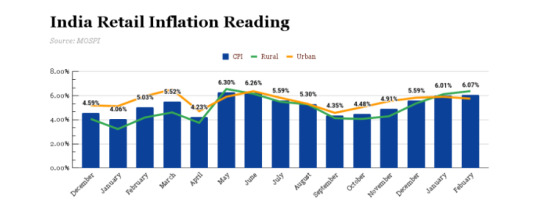
If we look at the inflation rate, it was seeing a continuous surge from October, and the recent data of May shows that it has reached 8.6% highest since 1981. This exponential increase in the inflation rate is attributed to the rise in food inflation. Various economists suggest that the R.B.I rate hike will not be able to tame this inflation because of the international phenomenon. Instead, it will hurt the growth prospects.
If we look at the data more carefully, we will find that a fast-forwarded rate hike was unavoidable because of five primary reasons- (Joshi, 2022)
Broad-based inflation- The recent inflation is not just the result of the international phenomenon; various factors have made it long-lasting and broad-based. It’s not just our headline inflation (which includes food and fuel) surging. Our core inflation, too, is hovering around 6.8%. Every commodity in RBI’s basket shows an increase in prices, making inflation broad-based.
Constitutional obligation- Monetary policy committee is constitutionally obligated to keep the interest rate at 4% (+/- 2%); if we look at the graph since January, it has been above the allowed limit, and even the recent R.B.I inflation expectation is showing that it will be 6.7% which means that this fiscal year inflation will be above the allowed threshold. R.B.I. has to give the government reasons for the same as the Monetary policy committee’s primary responsibility is to control inflation.
Negative Real Policy Rate- Our repo rate is still below the pre-pandemic level. If we see our real policy rate, i.e. interest rate minus inflation, we will find that it is negative, which means that the value of money deposited in our bank is getting eroded in real terms; this will have a direct impact on savings pattern.
Higher inflation expectation- The recent RBI inflation expectation survey and IIM Ahmedabad inflation expectation survey show that people feel that inflation will also remain high for the upcoming period. The different studies suggest that higher inflation expectations hurt household expenditure patterns; Juster and Wachter, in 1972, did the research and established that higher inflation expectations result in lower spending on durable goods. (Shankar, 2015)
Increase in interest rate by Federal reserve- With the increase in federal fund rate, India has seen a massive outflow of capital; till the 10th of June, 25 billion dollars had been withdrawn by the foreign portfolio investors. The Fed is expected to increase its fund rate further; hence, RBI must increase its repo rate to tackle the impact.
Though the rate hike was unavoidable, that doesn’t mean we can negate the impact it will create on consumption patterns and demand in the economy. But the normal forecast of monsoon and increase in consumer confidence, as reflected in the RBI survey, does give the cushion to MPC to decide on a rate hike. Also, the allowance of credit cards to be linked to UPI will push the consumption of small, durable goods like laptops, smartphones and other small-ticket items. The risk that this unanchored inflation poses to macroeconomic stability is enormous, and the central bank must be ready to answer these complications.
Joshi, D. (2022, June Friday). Google. Retrieved from Indian express: Dharmakirti Joshi writes: RBI leans harder to rein in inflation, but rebound in services will put upward pressure on prices
Shankar, S. Y. (2015). Inflation Expectations and Consumer spending in India; evidence from consumer confidence survey. Reserve bank of India occasional papers, 41-43.
0 notes
Text

Masulipatnam Port: The dead dock town
Machilipatnam, or Masulipatnam, which once flourished as a cosmopolitan town during the British Raj, was full of activity. Later, it was thrown into a dead dock due to multiple reasons. The port city, which once had a glorious past, is now affected due to the present state of affairs. How did the Machilipatnam port become uncompetitive compared to the other port cities like Visakhapatnam? Let’s dive into it.
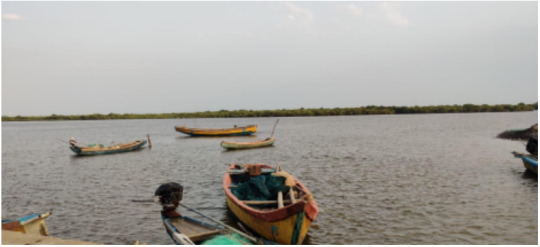
There were colourful boats lined up at the canal in an ideal way, and there were no preparations undertaken to sail into the sea due to the off-season. All those associated with the fishing and allied activities were left with no work at the port. Even if the season begins, the fishers of this region are at a disadvantage of sluggish activities that take place over here. Before getting into the details, let’s try to know the historical background of this town.
Historical Background:
This coastal town is mentioned in ancient and medieval era books on how the settlement in this place flourished. It was mentioned in some of the Buddhist texts, showing that settlements existed during ancient times. This town finds its place in “Periplus of the Erythraean Sea” and “Travel in India.” The latter mentions that the “people of many nationalities with different languages existed here and was more like a cosmopolitan city.” This town also flourished during the Qutb Shahi era during the 14th and 15th centuries. Indeed, it was one of the first places the East India Company set up a factory in the early 17th century. However, the fall of this coastal town was frequented by cyclones, and soon people migrated to nearby places like Vijayawada. Following this, the British shifted its factory to Madras.
Present Scenario:
The biggest hurdle that the fishers face in this port area is the problem of sand dunes. Due to this, the boats are getting damaged after hitting the dunes as the canal is narrow. Most of the time, dredging and desiltation is not done due to a lack of any responsibility measures. Once the boat gets damaged, the repair activities do not occur due to a lack of money. Unfortunately, they do not have an insurance policy on watercraft to be compensated.
There were numerous surveys made earlier by the government officials to know the existing problem and find a solution. But the present state of affairs reflects how the action has been taken at the ground level. Thanks to politicians who made numerous promises before every general election. Unsurprisingly, many of them failed to meet their commitments after getting elected.
The once-proud port lost its charm due to such ignorance, which eventually affected the trade activities, and therefore most of the boats that reach the shore are used for fishing activities. Due to this, some of them migrated to other nearby places like Vijayawada in search of their livelihood. Some stayed back and are willing to continue living for the rest of their lives and perish over there rather than moving to other nearby places. However, these fishermen ensure that their children get proper education and make a shift in their profession as there are no employment opportunities in this portfolio for them to sustain.
Nonetheless, they are equally worried about the increase in oil prices and the low marketing cost of the fish when compared to other port areas. Also, the local fishers face massive competition from the people coming from Kakinada, Nizampatnam, Visakhapatnam, and Madras. The local fishers are unhappy about not having regulations on anglers coming from other states like Tamil Nadu and Kerala. Even if the complaints are filed with the police, there won’t be any serious action taken due to political unwillingness to interfere in this issue.
Conclusion:
The only hope for them is the development of a harbour that could help them be more than a fisherman. Even though the nature of developmental activities that began right now is quite sluggish, they still hope that the harbour’s development work will soon be a reality. They believe that harbour would bring all the facilities like fish drying platforms, dormitories, commercial complex, marine police station, etc., which would eventually create employment opportunities and arrest the scenario of migration to other places in search of better opportunities. They wish to see that the harbour should be developed with state-of-art technology and ambience, eventually increasing trade activities and creating employment opportunities for generations.
0 notes
Text

Applications of Academic Writing in Public Policy
What can training in academic writing offer to students of public policy? We might think that public policy practitioners are far removed from the abstractions of academia, and that communicating about interventions on an issue requires something other than communicating, for example, one’s research on it. Yet the practice of academic writing teaches many important skills that can serve practitioners well.
At its core, academic writing is argumentative and persuasive. Here, writers have an argument, a point to make; they must use evidence to substantiate that argument. When seen from this perspective, the training that academic writing offers is important to anyone in a field where others must be persuaded of one’s opinions. Developing policy requires being able to convince others that one’s proposed solution to a particular problem will be appropriate and adequate. It requires the marshalling of evidence in favour of one’s proposal, thinking of the audience (and at times, multiple audiences) that one is addressing, and presenting one’s ideas with clarity and precision.
It’s tempting to think that these are skills that we all possess, or that they are picked up through the process of one’s education without any specific training. Our struggles with writing belie these ideas. Often both the process and end product of writing are murky. How do we know when we’ve written something well? How do we know where to begin, what to say next, when to stop? What can we assume our audience knows, and what will we need to explain?
The teaching of academic writing engages with all these questions. Here, writing is not treated as a talent that one either possesses or does not. Instead, it is treated as a skill that can be learned with the appropriate instruction. Students are taught to take a step back from their writing and learn to see it from their readers’ perspectives; to establish a correspondence between the arguments that they are making and the evidence they have to support those arguments; to draw on and acknowledge others’ ideas and data; to frame their ideas into a clear and readable narrative. These are important skills for anyone whose writing seeks to persuade others.
Amongst the most important contributions of the training in writing is how it gives students a greater confidence, in their ideas and in their capacity for self-expression. Working out an argument on paper is vastly different from working it out in one’s head. The act of writing and seeing one’s ideas on paper highlight all the nuances, the gaps, the strengths and shortcomings of those ideas. Being able to read, review and revise one’s ideas gives students the confidence that comes from knowing that their ideas are sound; and the practice of writing those ideas clearly and systematically shows students that they can do justice to their ideas when presenting them before an audience. Academic writing is not a mechanical exercise of preparing bibliographies and meeting word limits: it is an exercise in building the skills needed for self-expression.
As a writing teacher, I’ve had students tell me that they feel inadequate in front of their peers; that others have better ideas than them and can express them better too. Usually, I feel, they think that their peers simply possess some special quality that they lack. Training in writing helps break this myth, by showing that every idea and every expression of an idea is subject to revision and continuous refinement. Training in writing is as a nascent stage in Indian academia today; but as its benefits continue to be felt by teachers and students alike, we can hope that it will grow further.
0 notes
Text
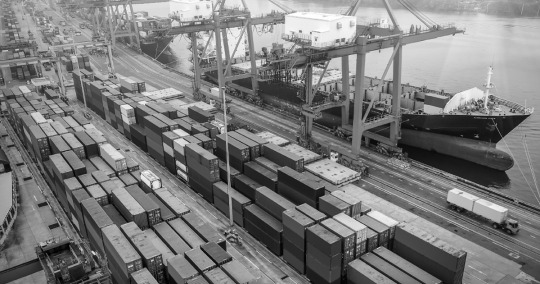
Import Substitution: A Tried and Tested Policy for Failure
Import substitution is a policy by which the state aims to increase the consumption of goods that are made domestically by levying high tariffs on foreign goods. This gives an advantage to the domestic manufacturers as their goods will be cheaper and preferable in the market compared to foreign products. India adopted this model post-independence, and it continued till the 1991 reforms. Due to import substitution, the domestic producers captured the entire Indian market, but there was slow progress in technological advancements, and the quality of Indian products was inferior to the foreign manufactured ones. But after the reforms, the Indian market was opened to everyone, and the consumer got the best value for the price he paid. The Make in India policy of the present government is reminiscent of the pre-1991 inward-looking Indian state.
Even though Make in India is not a classic import substitution case, it aimed to reach that end. Manufacturing in India was consistent as its contribution to GDP stayed between 12% and 18% from the 1960s to now, and the reforms of 1991 made little changes to that while the services kept growing. Hence, it is tempting for any government to aspire to an India which is a manufacturing hub and is not dependent on anyone. But the problem is that manufacturing a complete product requires different parts, each of which is imported from various places. There is value addition at every step of the supply chain. For example, the Production Linked Incentive (PLI) Scheme supports the manufacturing of mobile phones in India but we cannot be completely Atmanirbhar as the customized semiconductor chips are all produced and imported from Taiwan.
Another issue of concern is the apparent change in the political mindset. The thrust of the ruling dispensation has also somewhat been to that end. Various statements have been made and publicized to urge the Indian consumer to buy local. This directly supports an inward-looking economy that goes against an open market’s heart.
This is the pre-1991 era mindset making a comeback. A ’good product’ is an objective fact, and if a product is not competitive abroad, how can it be competitive at home? It is asking the consumers to compromise on the value while spending more. Former NITI Aayog Vice-Chairman Aravind Panagariya says that import substitution can decrease the growth of Indian GDP by 2 percentage points annually. He also mentions that when import substitution was implemented for electronics, the imports almost doubled in value in 5 years, but the exports barely increased in comparison. This is due to the lack of competition.
The main problem with import substitution is that it decreases quality by killing competition. When the foreign products are effectively stopped from entering the market, the domestic producer will not have any incentive to better their product. As the standards go lower, the quality of the product follows, and Indian products will not be able to compete globally. For any country to become an exporting power, it needs to import a lot. China and US, the top two exporters globally, are also the top two importers in the world. You cannot export much by going soft on import substitution as you will not have access to the latest technology, best practices, and human resources, which will hamper productivity.
Hence, import substitution will only weaken India by creating an inefficient economy that can neither produce adequately at home nor compete actively abroad. The revival of this policy will not yield any new results.
Insanity is doing the same thing over and over again and expecting different results – Albert Einstein
References:
India can grow at 10% but import substitution policy could hurt that, Arvind Panagariya says. (2020, August 29). ThePrint.
India can grow at 10% but import substitution policy could hurt that, Arvind Panagariya says
India’s trade policy: Import substitution or tariff intervention? – India business & trade, an initiative of trade promotion Council of India. (2021, July 15). Trade Promotion Council of India – Official website of Trade Promotion Council of India.
India’s trade policy: Import substitution or tariff intervention?
Manufacturing, value added (% of GDP) – India. (n.d.). World Bank Open Data | Data.
Manufacturing, value added (% of GDP) – India
Panagariya, A. (2020, July 22). Don’t resurrect failed policy: Why import substitution industrialisation is doomed to flounder, again. Times of India Blog.
Don’t resurrect failed policy: Why import substitution industrialisation is doomed to flounder, again
Rawat, M., Raj, R., & Agarwal, T. (2020). A critical review of make in India as an import substitute. SSRN Electronic Journal.
A Critical Review of Make in India as an Import Substitute
0 notes
Text
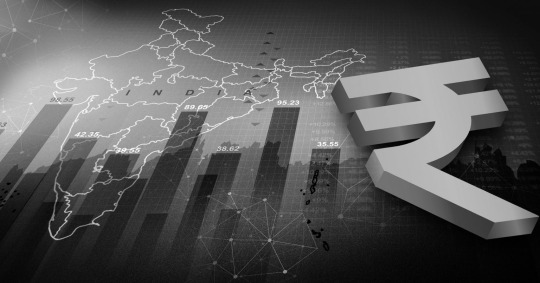
Inequality in the booming Indian economy
After the introduction of the economic reforms during the 90s, the Indian economy has seen an upsurge in its growth, making itself an important player in the world economy. Although it is still a relatively poor country, its rapid economic growth has led to a significant fall in the number of people living below the poverty line, improving their living standards. However, despite a burgeoning economy and reduction in poverty, the inequality in terms of distribution of income and wealth tends to be on the rise. It should be a matter of concern for academicians and the government to reduce poverty and economic inequality; nevertheless, many economists suggest that economic growth is collateral. But to what extent are these inequalities fair and just?
The United Nations 2015 adopted 17 Sustainable Development Goals as a universal call to end poverty and reduce income inequalities; however, dominance by the affluent in market economies does not allow for such measures to take place effectively, and such policies are not pursued to a much greater extent by governments is a sad reality.
Historically, inequality has existed across marginalized communities of SCs, STs, OBCs and minorities living in an absolute deprivation of economic resources. It is noted that inequalities across religious and caste groups are far worse. Hindu Forward castes are much better than the national average; however, Muslims are worse off than the urban Dalits and Adivasis.
Speaking of gender inequalities, as discussed, women being more prone to precarious employment puts them a risk of oppression by men due to increasing inequalities.
The gap in income and consumption expenditure inequalities has been greater in urban areas than rural; nonetheless, in the post-reform period, it has widened in most Indian states and in India. As India’s single most important asset, the land is more unequally distributed than other economic resources.
It is also vital to note that consumption plays an important role in calculating inequality.
Consumption represents typical income and is considered more stable than measured income, which is subject to seasonal fluctuations. This usually happens as people try to balance out their spending overtime when their income changes by borrowing or saving.
The Indian government, in order to alleviate poverty, has stressed rapid economic growth, for growth has generated employment to alleviate poverty but has failed to address growing relative deprivation among individuals, which has pushed the downtrodden further down the road. According to the latest World Inequality Report 2022, India appears as a poor and economically unequal country with widening differences between the rich and the poor with an affluent elite with the top 10% of the population owning 57% of the total national income and the bottom 50% owning only 13%. These figures represent how focusing on absolute deprivation than relative deprivation of the poor leads to poor economic growth.
Therefore, a reduction in relative income inequality can help boost the economy. Focusing on economic growth to alleviate poverty and also stressing government intervention in reducing economic disparity can help achieve overall gains for the country.
To provide the economic benefits to all, progressive taxation of individual income and wealth of the rich and providing cash transfers and subsidies to the poor will expand the economic gains of the poor. Moreover, an increase in minimum wage during an increase in inflation can help boost the economy. The recent spread of COVID-19 disease has further exacerbated the trend of economic inequality by making the poor jobless. Many had to suffer severely because of poor public health conditions. Government expenditure on education and health care and social welfare is said to reduce inequality. Investing in health care for the poor and improving quality education for them can help boost the economy as it will open the door to opportunities which will have a positive impact on eliminating group based negative discrimination and promoting societal cohesion. Furthermore, providing equal opportunities for growth to the poor will help boost the economy and help limit the role of money in politics as the powerful often tend to influence policy-making and will help strengthen their trust in the legitimacy of the political system.
How income inequality in India can be narrowed. (2022, February 16). The Hindu BusinessLine: Business Financial, Economy, Market, Stock – News & Updates.
How income inequality in India can be narrowed
When it comes to inequality, consumption is what matters.(2016, April 7).
Economics21. When It Comes to Inequality, Consumption Is What Matters
How economic inequality is widening in today’s India.(2015, August 5).Down To Earth | Latest news, opinion, analysis on environment & science issues | India, South Asia.
How economic inequality is widening in today’s India
WEISSKOPF, T. E. (2011). Why Worry about Inequality in the Booming Indian Economy?
Economic and Political Weekly, 46(47), 41–51. Why Worry about Inequality in the Booming Indian Economy?
0 notes
Text

Common But Differentiated Responsibility in Addressing Climate Change.
The whole world benefited from globalisation; it made a borderless world and gave us many things and opportunities. Products travel halfway across the globe to reach consumers. People travel through modern transportation to every corner of the world. Perhaps the only and most hazardous implication of such progress is climate change. The farther a product or human travels, the more energy they consume. Energy derived from fossil fuels results in emissions. The consequences of little luxuries are exponential.
It is a global challenge, and its consequences affect all countries. The Kyoto Protocol is an international treaty adopted in Kyoto, Japan, on 7 December 1997 and entered into force on 16 February 2005. The notion of “common but differentiated responsibilities” is the basis of the Protocol. The Protocol places a higher responsibility on industrialised countries, recognising that they are primarily responsible for the current high levels of Greenhouse gas emissions in the atmosphere as a result of more than 150 years of economic activity. They are to give financial resources to developing countries in order for them to engage in emission reduction initiatives, as well as develop and transfer environment-friendly technologies to developing countries.
The concept of Common but Differentiated responsibility was formally acknowledged in 1992 at the United Nations Conference on Environment and Development held in Rio De Janeiro. Environmental degradation is a common obligation that speaks to every state, but the responsibility that every state bears in order to help the situation varies not only depending on their contributions to the crisis in the first place but also on their ability to expend resources. A country like Australia can spend its resources on finding sustainable solutions to environmental degradation, and researching and harnessing clear sources of energy, but a country like Sudan can at the most record its data. A country like Sudan is also so underdeveloped that it doesn’t leave any carbon footprint. People don’t own a lot of vehicles, and there’s no proper modern transportation or roads for connectivity. They produce so little they can’t export. What they need to import they can’t afford. There’s little to no industrialisation. Given all of these facts, it would be unfair for a country like this to contribute to a universal fund or take measures to curb climate change internally. Weighing all of these determinants, a common solution is not an option. Common but differentiated responsibility holds everyone accountable but gives enough leeway for states to act independently within the framework of the goals set every 5 years to achieve the maximum amount of efficiency.
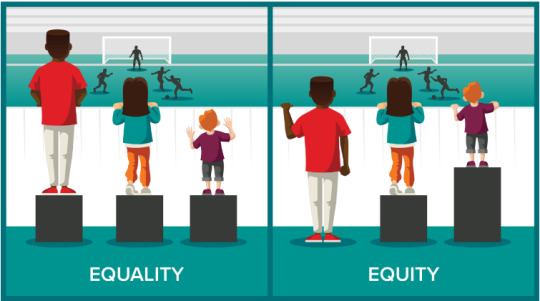
This simple picture illustrates equity, not equality of opportunity but equality of outcome. Doing everything one can possibly do with their means, however humble or grand they might be, to ensure we curb climate change and cap it off is equity. We want a clean and sustainable earth, and giving every country a neat sheet of the same required things to do to achieve that is a pipedream.
If any international organisation gave a universal standard set of measures that need to be taken by every state regardless of its development or economic status, underdeveloped countries struggling to bring their people out of poverty would give this crisis a backseat and would do nothing at all and developed countries with advanced technology and resources would do whatever is required and call it a day. Developed countries have the capability to take on the task of reducing emissions. If not asked to utilise these capacities, their resources would languish, which would prove useful to no one. The wide differences in the economic development of different states make it impossible for everyone to expend the same resources to fight for this cause.
Another equally important argument is the fact that developed countries cause (or caused) relatively more environmental degradation than underdeveloped countries. Development meant industrial revolutions, and industrial revolution meant environmental degradation. There was also very little awareness, and many disruptive advancements were invented without understanding any real ramifications. Developing nations have rapidly increasing amounts of greenhouse gasses. Industrialised nations reach a peak, and from that point on, their emissions decrease. It is widely believed that for a nation to start decreasing its emissions, it first has to reach its peak and go steadily, decreasing its anthropogenic emissions over periods of 5 years till there is a 10% reduction compared to its peak. This is called Peaking, and for this to happen, development should be the first priority.
Climate change’s consequences have already been seen around the world, and they are projected to worsen as global temperatures rise. As sea levels rise, ice sheets and glaciers are fast meltings, forcing low-lying populations to relocate and jeopardising water supplies for millions of people. Though every country in the world recognises the seriousness of the situation, there is a conflict of interest between developed and developing countries in terms of the measures that each group must take to alleviate the detrimental effects of global warming.
The debate of whether the principle of “common but differentiated responsibilities” is fair has been going on for quite some time now, and developing, and developed countries are sparring as to who is responsible instead of taking any real action and working towards a better future. Debates like these steal the attention away from the matter at hand, making us forget the grave situation all of us are in. Instead of trying to determine who is the most to blame, counties can try to work together and do whatever is possible to curb this crisis. If not taken seriously, the consequences of our mindless disputes disguised as negotiations and deliberations will have solemn consequences.
0 notes
Text

Countdown Begins for TB Mukt Bharat.
24th March is observed as World Tuberculosis Day in the memory of Dr. Robert Koch.
In 1883, Dr Robert Koch discovered the bacteria that causes TB. However, it took 60 years since then for the discovery of its’ cure and another 6 years to actually test it on a human patient. Since then, there have been many scientific breakthroughs to detect and cure this disease, however, it continues to haunt many developing nations as a major public health challenge. WHO has recognized TB as one of the top 10 causes of morbidity and mortality in 2019. Even though it is prevalent in Asia, Africa, Caribbean countries etc, India alone accounts for over one-third of deaths in the world. COVID-19 pandemic has only made it worse.
In 2018, Prime Minister Narendra Modi announced to make India free of Tuberculosis in 2025, which is 5 years before the SDG 2030 timelines. This was a huge commitment. To bring this to fruition, multiple stakeholders, especially the Ministry of Health, Ministry of Women and Child, ICMR, National Institute of Research in Tuberculosis (NIRT) and the States have engaged and planned to eliminate this communicable disease, but how close are we from the intended goal?
In the recent report released by NIRT, Chennai – ICMR on 25th March 2022, there are revelations and insights that policymakers working in this area must actively look into. The report indicates that a mammoth nationwide survey, targeting over 3.5 lakh people was conducted before and during the COVID pandemic. NIRT aimed to cover 625 clusters across all states of which only 448 could be covered. The BIMARU states along with Haryana, which have higher incidences than the national average, defaulted the most from the protocol with each targeting less than 60% of the intended clusters. But, to give credit where its’ due, the will to complete this survey showed the commitment of all stakeholders to eliminate TB from India.
The report contains a study on the ‘Health Seeking Behavior’ of over 3 Lakh symptomatic participants across India, which clearly shows that of the 14k people showing symptoms eligible for a sputum test, 65% did not consult for TB symptoms due to various reasons, the most alarming being “Ignored symptoms – 68%” and “Could not afford to seek care – 11%”. Even though Government of India under various programmes and schemes is provisioning for free-of-cost diagnosis and cure along with awareness campaigns in all mediums, the impact is clearly questionable.
India has done well, but time is ticking away. 2025 is not far and we are way behind in achieve the goal of eliminating TB from India. If we only talk about pulmonary TB cases, the policymakers must consider recommendations given by NIRT with respect to including X-Ray and Molecular testing for more effective detection of TB. Given the current inflation (both urban and rural) in India because of various global phenomena, Nikshay Poshan Abhiyaan scheme to give direct cash transfers to patients of Rs. 500 for 6 months each, might not meet its intended goal of improving nutrition levels. Also, research shows that the duration DOT treatment can be reduced from 6 months to 4 months in cases where the severity of infection is lower. Making detection, escalation and treatment more robust is imperative.
We need a targeted approach for eliminating TB. The targeting must be done to cater to the most infringed and untouched parts of the populations in tribal areas, as well as remote parts of India, who have a deviant lifestyle with respect to prescriptions for TB, owing to traditions, social interactions or education levels. Women and Children must be given special attention to this approach as per their nutrition needs. States which are performing ineffectively, must catalyze their efforts and align with the national mission and create real-time dashboards for transparency and public involvement. Every state must trickle down district based targets for each day.
Lastly, the most vital means is awareness. Effective messaging should be given utmost importance to hammer the gravity of the situation in the minds of all sections and sub-sections of India, especially the states where the curative health infrastructure is in tatters. Early detection for better response should be one of the mantras going forward. Simultaneous capacity building for health infrastructure and awareness programmes to nudge people to take the tests will catalyze detection and give a better picture for conceiving subsequent mitigation strategies.
If we wish to make India ‘TB Mukt’ as early as possible, we take the right steps in the right direction. This cannot be done by Government alone as seen in the reports as well, support from private sector and Civil Soceity Organizations are a must. With ongoing research for easier solutions and a potential one-time vaccination for TB elimination underway, it is not an impossible dream but a tedious one at that.
0 notes
Text

Navigating Through Warp & Weft

In this picture is Mr. Narasimha and his weaving machine, called Maggam in Telugu. I had met him on my visit to the town of Pochampally, situated around 50kms from Hyderabad. It is known as the Silk City of India because of the gorgeous sarees woven in a distinctive design known as Ikat. Mr. Narasimha is a handloom weaver of Pochampally silk sarees, mastering this for the last 25 years and his family has been doing this for generations. Usually, it takes four days to weave a single saree while working on it for 6-7 hours each day: One person can only complete seven sarees per month. There are around 1600-1700 people who are into weaving these sarees in this town and most of them belong to a caste called Padmasaleelu.
Initially, this used to be a cottage industry, and all of them had the Maggam Machines inside their homes. Slowly, as the business declined, it became difficult for individual weavers to survive on their own & they became contractual labour in the hands of Master weavers. One of the reasons for this shift from a self-owned cottage industry to becoming contractual labour in the hands of a proprietor, is lack of working capital & the issue of Loan waiver. There is a scheme solely dedicated to the weavers called Weavers MUDRA Scheme. Under this scheme, the weavers can borrow money to fund their working capital. A few years ago, the government of Telangana had announced that they would waive off the loans for weavers. The likes of Mr. Narasimha were encouraged by the local elected representatives to not pay the loan and wait for the waiver. This waiver took around three years to concretize, and even then, only 20%-30% of the principal amount was waived off. Finally, it has led to a decrease in their credit scores, and the banks are now refusing them to give loans. Due to this, they have no option other than working for the proprietors.
As I ask Mr. Narasimha about the weaver community’s issues, he shares that one of the most significant issues is the volatile input cost, especially the silk thread. The thread is ordered from Bangalore, and some of it is imported from China. Due to COVID, the imports from China have decreased in the last two years, and due to less rainfall, domestic silk production has taken a hit. Also, Mr. Narasimha hints at forming a syndicate in Bangalore where this silk thread is being bought at a slightly higher price by the power loom companies to produce silk curtains. These are then exported to European markets. All of these reasons together, have led to the rise in input costs of the saree. As I nudge him towards inquiring what could be done by the government to ease their troubles, he hesitates, and his colleagues chip in with their suggestions. They ask for a minimum amount to be fixed on sarees so that the market forces don’t exploit them. They also want a higher subsidy on the input of nearly 20%; currently, the input subsidy stands at around 10%, but it’s only for the cooperatives. Finally, they want the process of direct procurement by the government to be made more efficient. There is a massive delay in the payments by the government to weavers, so most of them prefer to sell their products to private buyers even for a lower price.
While going towards the Pochampally, I came across a power loom industry in the outskirts, and I asked Mr. Narasimha if these power looms affect their business. He proudly says that this is one thing the technology or the power looms cannot snatch away from them. The intricate design of these Ikat sarees mandate a human touch. The power looms can only produce plain and straightforward products, mainly curtains. During the interaction with Mr. Narasimha and his fellow weavers, I also realized that this was more art for them than just an occupation. It’s a skill that is being passed on to them from generations. It isn’t just about money; it’s more of a cultural thing. To move away from this generational occupation is to lose their identity and existence.
As we moved towards the end of our conversation, I gathered the courage to ask my naïve question about why this Pochampally Ikat only has to be a saree. Why could it not be a shirt, and maybe it could be marketed as a new thing in the market? With a wry smile on his face Mr. Narasimha very patiently answered that if a shirt were to be made, each one piece would cost more than Rs. 5000, and he said to me, “Would you buy one at that cost?”
0 notes
Text

Overview of Sports Challenges and Policies in India
The complementarily of physical and mental health were stressed by the Greek philosopher Thales and the Roman poet Juvenal when both desired the idea of a ‘sound mind in a sound body’. Sports is one of the key determinants in the development of a sound body and plays a significant role in the development of fundamental movement abilities and physical competencies in the initial stages of life (Childhood), which are crucial prerequisites for later participation in lifestyle. A physically fit individual leads to an equally healthy society. There is growing evidence that sports can act as a catalyst for the development of personal and social skills among youngsters. The incorporation of sports into one’s day-to-day life increases confidence, self-image, and personality, as well as paves the path for a sports career. The potentialof sports to be considered as a career option gives rise to the question of its position and preference compared to other conventional career alternatives. In India most families pressurize their children to outshine in academics and work hard towards becoming an Engineer, doctors or successful entrepreneur. The underlying feeling is that sports does not fetch a decent livelihood or make one wealthy. There are numerous obstacles, including socioeconomic, linguistic, religious, cultural, dietary habits, societal taboos, and gender bias that hinder a huge chunk of India’s young aspiring population to continue their passion for sports. This throws the challenge of working out an in-depth assessment to learn about community perceptions of physical education and sports, particularly among young people, and what impediments they encounter in obtaining opportunities to hone their sporting talent
Potential sports persons are chosen and well facilitated by their family, community, and respective governments during their early teens in the rest of the world as compared to India. Sport has historically taken a back seat in the Indian education system. A shift in school attitudes about sports has the potential to reshape the sporting landscape and provide more possibilities for various sports roles. The government of India has been making many endeavors to improve the current mechanism of sports and the Khelo India initiative is one of them. The aim of the initiative is to strengthen sports and meet the twin goals of mass engagement and sports excellence. The games of the initial target the primary school children can serve as a platform for spotting emerging sporting talent in several categories. For the first time, an annual stipend for sporting equipment has been made available under the Samagra Shiksha. Every government school would get a sports grant of ₹ 5000 for primary schools, ₹10,000 for upper primary schools, and up to ₹25,000 for secondary and senior secondary schools to cover the cost of purchasing sports equipment for both indoor and outdoor games.
Despite these remarkable plans and rules, sports in India has been an arena where the application of the law has been lacking; India consistently ranks first when it comes to Anti-Doping Rule Violations or the World Anti-Doping Agency’s Adverse Analytical Findings. Many other hurdles exist in the form of ongoing legal fights, such as contractual violations, intellectual property violations, and conflicts. One major concern in India’s sports world is the lack of transparency and accountability of athletic federations and organizations, which, despite being regulated by the Indian government, enjoy unrestricted and monopolistic influence over the sports they regulate. Due to recent scandals and controversies, such as the IPL Scam, Olympic Gamesbidding scam, sexual harassment incidents in women’s hockey teams and many other sports, and the usage of forbidden performance-enhancing chemicals, there is an essential need for a stringent regulation in sports.
The existing Indian sports governance paradigm clearly lacks accountability and transparency, creating a climate susceptible to widespread corruption. Many analysts believe that scarce public investible resources have evaded sports at both the national and international levels in India. Misallocation, lack of transparency, poor asset management, and the lack of a framework for monitoring the impact of government expenditure exacerbate the problem. In order to fix the current impediments of the sports in India there is a need to develop policies to encourage as many students as possible to participate in sporting events and competitions at the university level, Developing a holistic approach to skill, agility, flexibility, poise, coordination, strength, and endurance, among other things. Persuading the media to use its pen and voice to improve public perceptions of sports and games. In physical education and sports-related courses, review and modify obsolete curriculum, teaching and learning methodologies, theory, and practicum assessment rubrics India would have to invest extensively in contemporary facilities and a strong grassroots system if it wants to become a sporting nation.
References
Chennapragada, S., & Jain, S. (2020). Demystifying India’s Paralympic movement: Overview of legislation, sport governance and ground realities. The International Sports Law Journal, 20(3), 191-202.
Jain, S. (2020). Sports Administration in India: Legislative Framework and Judicial Pronouncements. Available at SSRN 3626923.
Flores, A. R., Haider-Markel, D. P., Lewis, D. C., Miller, P. R., Tadlock, B. L., & Taylor, J. K. (2020). Public attitudes about transgender participation in sports: The roles of gender, gender identity conformity, and sports fandom. Sex Roles, 83(5), 382-398.
0 notes
Text

The Sri Lanka Economic Crisis
Sri Lanka’s economic collapse is really very tragic. For a long time, the country was projected to be the next Asian tiger, but it is currently struggling to keep its balance sheet in order. Several factors have driven the economic situation to the point where it is currently, including the government trajectory.
The Sri Lankan government declared an economic emergency in late August last year, citing rising inflation, a weakening currency, and rapidly depleting foreign exchange reserves. However, none of the policies that the country has employed have been able to improve the situation. And now, the government of Gotabaya Rajapaksa has been shaken by a wave of spontaneous protests that have swept the country, threatening its survival.
While the epidemic has played a role in the economic downturn, the difficulties are mostly the result of its own actions. In 2019, populist tax cuts supported by money printing triggered a balance of payments problem. Despite repeated warnings from independent analysts, the government has stuck to its domestic policy of import substitution to save money.
Let us attempt to shed some light on the various aspects of Sri Lanka’s economic position that have resulted in the country’s current dilemma.
The Forex problem
Sri Lanka’s foreign exchange reserves are critically low, with only enough dollars to cover imports for less than two months. At the end of July, Sri Lanka had only $2.36 billion in foreign currency, compared to $6.93 billion in August 2020. The Sri Lankan rupee had lost 7.5% against the US dollar by the end of 2021.
In a bid to protect the local currency, Sri Lanka’s Central Bank hiked interest rates late last year, making it the first central bank in Asia to do so since the outbreak. Sri Lanka has typically borrowed to fuel its expansion, but throughout most of its history, it has benefited from low-interest concessionary loans.
Sri Lanka, however, had to rely on new finance sources once it reached middle-income status. According to a February 2021 article in The Diplomat, commercial borrowings accounted for 56 per cent of Sri Lanka’s foreign loans by the end of 2021, largely in the form of International Sovereign Bonds.
The impact of the balance of payments crisis has resulted in higher prices for items such as sugar, rice, onions, and potatoes, as well as long lineups outside stores, due to shortages of milk powder, kerosene oil, and cooking gas.
In addition to this, there are several more aspects to consider: The local economy has also been harmed by a drop in tourism, which accounts for nearly 10% of Sri Lanka’s GDP. The third-largest source of foreign exchange was tourism. Surprisingly, the tourism slump occurred before COVID-19: in 2019, tourist footfalls fell by 18%, the first drop in nearly a decade of constant increase.
The government appeared to believe that its troubles were mainly due to the virus, and that things would rapidly return to normal once tourism increased, however, this has also not been the case.
Economic policy: a factor in worsening situation in Sri Lanka
Gotabaya issued massive tax cuts shortly after taking office. In 2020, revenue is expected to drop by roughly 30%. After that, the government went on a money-printing binge. Between December 2019 and August 2021, the amount of money poured into the economy increased by 42%.
Even while people were grappling with rising prices and scarcity, Gotabaya struck again. His government outlawed the use of chemical fertilizers completely in May, 2021. Farmers were unable to sow at the start of the monsoon season due to the rain.
Food output fell and prices climbed as a result of this erroneous attempt to preserve foreign exchange by restricting the import of things like chemical fertilizers. At the same time, to service international debt, available foreign reserves were drained anyway. To put it into perspective, one should note that the agriculture sector employs two-thirds of Sri Lanka’s population.
The continuing problem
Over the past year, public discontent has grown as a result of increased costs and shortages of commodities such as cooking gas, food, and medicines. In January, fuel grew scarce, and power outages became increasingly common. As the country entered its hot season, queues for basic commodities and services stretched for miles, forcing consumers to spend hours in the sweltering heat.
In the first week of March, the currency plummeted and public outrage erupted as power outages were extended to up to 10 hours every day. For several weeks, a wave of spontaneous nonviolent public protests swept the country, expressing a compelling demand for change, but the government, strangely, did not respond or even acknowledge the problem.
0 notes